Highly Nonlinear Fibers (HNLF) for NIR Supercontinuum Generation
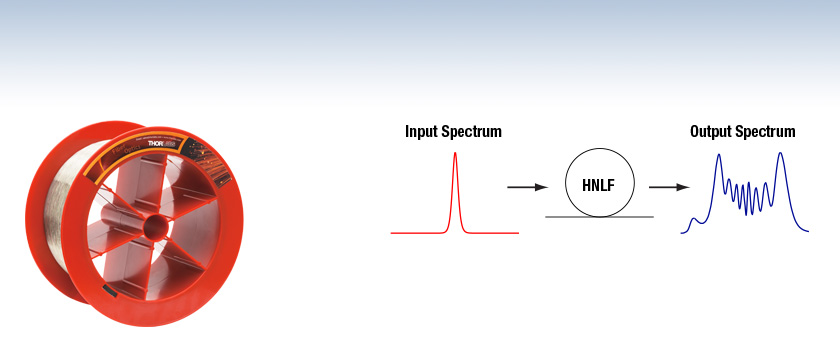
- SM and PM Fibers Available
- Near-Zero Dispersion for Supercontinuum Generation
- Ideal for Spectral Broadening of Femtosecond Pulses
- Low Splice Loss to Standard Fiber
HN1550
Application Idea
Highly Nonlinear Fiber (HNLF) can be used for nonlinear spectral broadening of femtosecond pulses around 1550 nm.

Please Wait
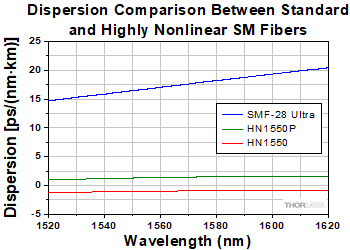
Click to Enlarge
Thorlabs' Highly Nonlinear Fiber has flat dispersion (zero dispersion slope) compared to standard SMF-28 Ultra fiber.
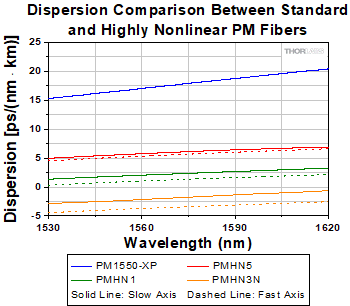
Click to Enlarge
Thorlabs' Polarization-Maintaining, Highly Nonlinear Fiber compared to standard PM fiber (Item # PM1550-XP). For PM1550-XP waveguide dispersion is negligible compared to material dispersion so only a single curve is shown.
Features
- Highly Nonlinear Fiber with Near-Zero Dispersion for Supercontinuum Generation
- Anomalous and Normal Dispersion Options for both SM and PM Fibers
- Nonlinear Coefficient:
- SM Fiber (Item #s HN1550 and HN1550P): 10.8 W-1•km-1
- PM Fiber (Item #s PMHN1, PMHN5, and PMHN3N): 10.7 W-1•km-1
- 10X Higher Nonlinear Coefficient Compared to Standard SM or PM Fiber
- Low Splice Loss to Standard SM or PM Fiber
Applications
- Spectral Broadening of Femtosecond Pulses
- Supercontinuum Generation
- Pulse Compression
- NIR Four-Wave Mixing Processes
Thorlabs' Highly Nonlinear Fibers (HNLF) are designed for applications that require a large nonlinear coefficient as well as near-zero dispersion around 1550 nm (C & L bands). The nonlinear coefficients of our HNLFs are approximately 10-times higher than that of standard SM fiber (for example Item # SMF-28-J9) or PM fiber (for example Item # PM1550-XP) at this wavelength. Thorlabs offers single-mode (SM) and polarization-maintaining (PM) HNLFs, and these fibers are ideal for spectral broadening of femtosecond pulses, as well as pulse compression; see the Spectral Broadening and Pulse Compression tabs for more information.
Single Mode HNLF
We offer HN1550 fiber with normal dispersion and HN1550P fiber with anomalous dispersion. Both fibers feature zero dispersion slope, as compared to SMF-28 fiber in the graph to the right. A primary application for these fibers is in nonlinear spectral broadening of femtosecond pulses in the 1550 nm band through self-phase modulation. This spectral broadening process can be used to generate broadband light sources (supercontinuum generation) and compressed pulses. Additionally, the combination of a high nonlinear coefficient and near-zero dispersion make the fibers ideal for four-wave mixing processes in this wavelength region.
HN1550 fiber features a small normal dispersion (-1 ps/nm•km at 1550 nm). In spectral broadening applications, the normal dispersion of the fiber creates a linear chirp on the pulse which is of the same sign as the chirp created by nonlinearity. As a result, femtosecond pulses propagating along HN1550 fiber would generally broaden in time while they undergo spectral broadening. In comparison, HN1550P fiber features a small anomalous dispersion (+1 ps/nm•km at 1550 nm), and the linear chirp caused by the fiber dispersion has the opposite sign compared to the chirp caused by nonlinearity. This enables soliton propagation and self-compression of pulses in the fiber. One consequence of this is the fact that the spectral broadening of femtosecond pulses can be achieved more efficiently and at lower power levels in HN1550P fiber as compared to HN1550 fiber. On the other hand, the broadened spectra in HN1550 fiber generally have better flatness in comparison with the HN1550P fiber.
Pulse compression in HN1550 fiber can be achieved by spectrally broadening the pulse and the use of a dispersive component with anamolous dispersion. Such systems can be designed to produce compressed pulses with high quality. In comparison, pulse compression in HN1550P fiber can be achieved by either self-compression or by a combination of self-compression and the use of a dispersive element. Additionally, HN1550P fiber is suitable for parametric amplification processes due to its anomalous dispersion. See the Spectral Broadening and Pulse Compression tabs for simulations of spectral broadening and pulse compression through numerical simulation examples using both fibers.
Polarization-Maintaining HNLF
The PMHN1, PMHN5, and PMHN3N fibers have elliptical core structures that make them polarization maintaining fibers. The fibers are ideal for laser systems that have a linearly polarized output, and the ability to maintain linear polarization results in added stability with respect to thermal or mechanical environmental changes. The PMHN1 and PMHN5 fibers feature near-zero anomalous dispersion at 1550 nm (+1 ps/nm•km for PMHN1 fiber and +5 ps/nm•km for PMHN5 fiber), and the PMHN3N fiber features near-zero normal dispersion (-3 ps/nm•km) at 1550 nm. The high nonlinearity and near-zero dispersion make these fibers suitable for power-efficient spectral broadening of femtosecond Erbium-doped fiber lasers. This property can be used in supercontinuum generation or for compressing femtosecond pulses. The different dispersion profiles can be seen in the dispersion plots to the upper right. The PMHN1 fiber dispersion profile is more appropriate for the generation of longer wavelengths above 2 μm. The PMHN5 fiber dispersion profile is more suitable for the generation of shorter wavelengths through the propagation of dispersive waves in the fiber and can extend close to the 1 μm band. See the Spectral Broadening tab for simulations of spectral broadening and pulse compression through numerical simulation examples using both fibers. The PMHN3N fiber has a normal dispersion profile which makes it suitable for spectral broadening with minimal spectral modulation due to improved spectral flatness.
Additionally, the combination of a high nonlinear coefficient and near-zero dispersion makes these fibers ideal for four-wave mixing processes in the 1530 nm to 1620 nm wavelength region.
Fiber Splicing
The HNLFs are designed with a small mode-field diameter of 4 µm in order to enhance nonlinearity. Therefore, splice recipe optimization or a bridge fiber should be used in order to minimize coupling losses between the standard fiber and the HNLF. Thorlabs can provide highly nonlinear fiber with standard fiber spliced to one or both ends. Please contact Tech Support to request a quote on splice services for this fiber.
Spectral Broadening
An application for highly nonlinear fiber (HNLF) is spectral broadening of femtosecond pulses, and the examples provided below for the HN1550, HN1550P, PMHN1, and PMHN5 fibers can be used as a reference for designing systems or experiments. Please note that all simulations are made with the assumption that the input pulses are transform-limited sech2 shaped pulses, and the indicated power levels are after coupling into the HNLF fiber. The simulation results are not guaranteed and should only be used as guidelines for designing experiments; see the specifications tables below for guaranteed performance.
Figures 1 and 2 show the evolution of a 200 fs pulse as it propagates along a 1 meter section of HN1550 or HN1550P fiber. We simulated pulses with average power of 80 mW at 100 MHz (800 pJ pulse energy) for the case of HN1550 fiber. The simulation was repeated for a lower average power of 10 mW (100 pJ pulse energy) for the case of HN1550P fiber, as this corresponds to the same spectral broadening due to the more power-efficient broadening in the HN1550P fiber. Figure 1 shows the temporal intensity profiles of the pulses after propagation through either the HN1550 or HN1550P fiber, while Figure 2 shows the spectra of the pulses after propagation through the same respective fibers. The HN1550 fiber broadens the pulse in both time and spectral domains, yielding a >600 fs long pulse and a spectrum spanning from 1300 nm to 1800 nm. In the case of the HN1550P fiber, self-compression to a <20 fs pulse width is evident while the output spectrum spans from 1300 nm to 1800 nm. The PMHN3N fiber has a normal dispersion and its spectral broadening and pulse compression performance are similar to the HN1550 fiber shown in Figures 1 and 2.
Figure 3 shows the evolution of an 80 fs FWHM pulse as it propagates along a 10 cm section of PMHN1 or PMHN5 fiber. We simulated pulses with average power of 100 mW at 100 MHz (800 pJ pulse energy), and the resulting spectra for both fibers show spectral broadening to more than one octave of bandwidth. Due to the dispersion profiles of each fiber, the supercontinuum generated in the PMHN1 fiber extends to longer wavelengths, whereas the supercontinuum generated in the PMHN5 fiber extends to shorter wavelengths.
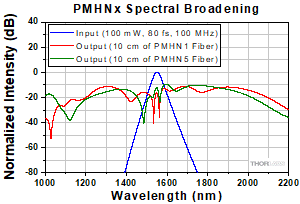
Click to Enlarge
Figure 3: Numerical simulation of spectral broadening in PMHN1 and PMHN5 fibers. The input pulses have an 80 fs FWHM pulse width and 100 mW average power at 100 MHz repetition rate. The pulses go through a 10 cm long PMHN1 (red curve) or PMHN5 (green curve) fiber and the simulated output spectrum is plotted.
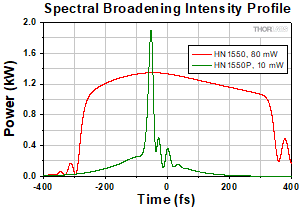
Click to Enlarge
Figure 1: Simulated normalized output spectra from 1 m long HN1550 fiber and HN1550P fiber seeded with 100 MHz, 200 fs pulses.
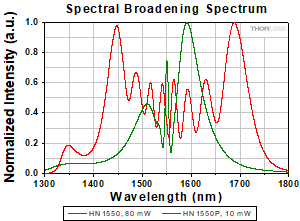
Click to Enlarge
Figure 2: Simulated normalized output spectra from 1 m long HN1550 fiber and HN1550P fiber seeded with 100 MHz, 200 fs pulses.
Pulse Compression
An application for highly nonlinear fiber (HNLF) is pulse compression, and the example provided below using HN1550 and HN1550P fibers can be used as a reference for designing systems or experiments. Please note that all simulations are made with the assumption that the input pulses are transform-limited sech2 shaped pulses, and the indicated power levels are after coupling into the HNLF fiber. The simulation results are not guaranteed and should only be used as guidelines for designing experiments; see the specifications tables below for guaranteed performance.
The diagram and plots below show how nonlinear broadening can be utilized for compressing pulses in time using either HN1550 or HN1550P fiber. Pulse compression in HN1550 fiber is only possible by external compression using a dispersive component with anomalous dispersion. Pulse compression in HN1550P fiber can be done by self-compression (as shown above) or by a combination of self-compression and external compression in a dispersive component with anomalous dispersion. While self-compression provides a simple approach, higher quality pulses can be achieved by a combination of self-compression and external compression. In the example shown below, a 100 fs pulse at 100 MHz repetition rate and 100 mW average power is sent into a short section of each fiber. A short length of bulk fused silica is then used to provide external anomalous dispersion for compressing the pulses. Figures 1 and 2 show the normalized spectrum of the pulse and its temporal intensity profile before entering the nonlinear fiber, respectively. By collimating the beam at the output of the highly nonlinear fiber and sending the pulses into bulk fused silica (anomalous dispersion, with negligible nonlinearity), the pulses are compressed in time. We simulate the propagation in 10 cm of HN1550 fiber followed by compression in 20 mm of bulk fused silica, as well as the propagation in 7 cm of HN1550P fiber followed by compression in 10 mm of bulk fused silica. Figures 3 and 4 show the output pulse normalized spectrum and temporal intensity profile, respectively.
Please note that by compensating higher-order dispersions, a cleaner temporal profile can be achieved. Higher compression factors can be achieved by additional spectral broadening of higher intensity pulses.
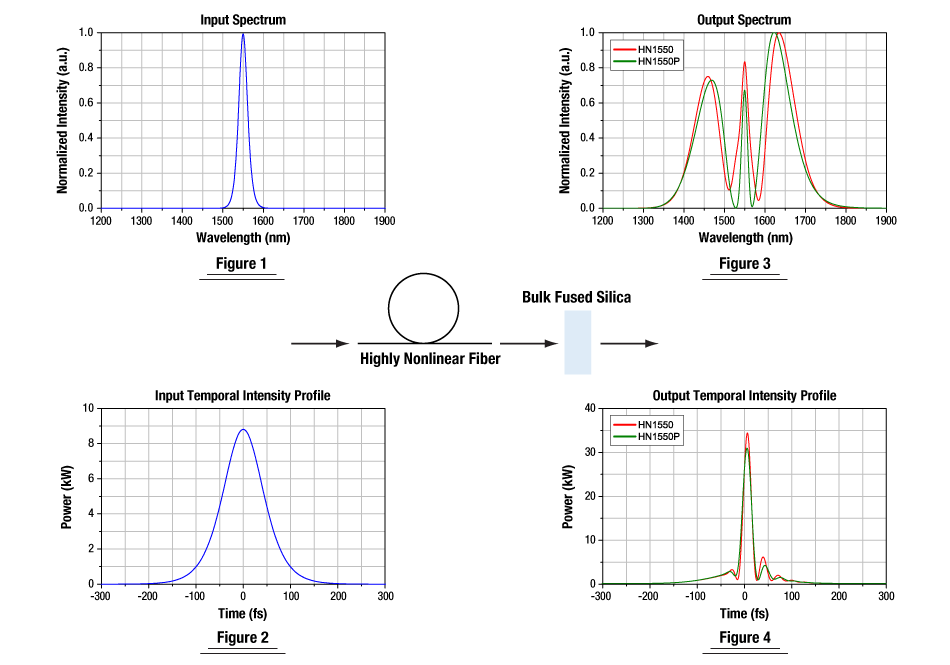
Figures 1 - 4: Input spectrums (normalized) and temporal intensity profiles for a pulse sent through highly nonlinear fibers. Output spectrums (normalized) and temporal intensity profiles for a pulse after propagating through the fibers and compression in bulk fused silica. The input pulse has a 100 fs pulse width, 100 MHz repetition rate, and 100 mW average power.
| Posted Comments: | |
Jianran Zhang
(posted 2023-10-12 17:28:08.79) May I know the ZDW of the HNLF? Is 1600-1700nm in its normal dispersion range? ksosnowski
(posted 2023-10-12 11:58:33.0) Hello Jianran, thanks for reaching out to Thorlabs. For these particular fibers, rather than a zero-dispersion wavelength, they have a minimum dispersion wavelength. For this fiber, the HN1550P, the minimum dispersion wavelength is close to 1620nm. The full graphical representation of this can be found by clicking the "dispersion" link in the specs table on the product page. Alexander Block
(posted 2022-09-13 13:33:54.15) I think the price should be in Per Meter. jgreschler
(posted 2023-01-06 10:12:00.0) Thank you for reaching out to Thorlabs. The prices listed are now in meters, we appreciate the input. user
(posted 2021-07-19 17:37:45.527) Greetings,
I see on the datasheet the values for the dispersion and the dispersion slope, but it doesn't say anything about the zero-dispersion wavelength. Where is the ZDW, is it at 1550 nm?
Thank you. cdolbashian
(posted 2021-08-10 11:43:31.0) Thank you for reaching out to us at Thorlabs! For these particular fibers, rather than a zero-dispersion wavelength, they have a minimum dispersion wavelength. For this fiber, the HN1550, the minimum dispersion wavelength is between 1595-1605nm. The full graphical representation of this can be found by clicking the "dispersion" link in the specs table on the product page. Ha CHANGKYUN
(posted 2021-07-19 16:38:19.163) Dear Thorlabs.
Is there any information of effective index in two nonlienar fiber products?
We want to calculate the group velocity, and simulate the four wave mixing process. Thank you! YLohia
(posted 2021-08-05 01:24:26.0) Hello, thank you for contacting Thorlabs. The refractive indices for these fibers is proprietary information and, unfortunately, we cannot share that. That being said, I have reached out to you directly with dispersion plots. Lawrence Trask
(posted 2021-05-02 15:48:23.183) Greetings,
I noticed that in the spec sheet and the ordering form that the dispersion of this particular highly nonlinear fiber (HNLF) is -1 plus or minus 1. I was wondering if it would be possible to get two different HNLF. One with dispersion at 1550 nm to be ~2 ps/nm/km and the other with dispersion at 1550 nm to be ~1 ps/nm/km. YLohia
(posted 2021-05-05 02:25:55.0) Hello, thank you for contacting Thorlabs. Unfortunately, these fibers cannot be customized for different dispersion parameters. My apologies for this. Kai Kruse
(posted 2021-04-21 02:58:53.69) We are very interested in the products HN1550 & HN1550P, but we would need a polarization maintaining fiber. Would that be possible?
Thanks, Kai YLohia
(posted 2021-04-21 11:31:11.0) Hello Kai, thank you for contacting Thorlabs. Custom versions of our fibers can be requested by clicking on the "Request Quote" button above. We will reach out to you directly to discuss the possibility of offering this customization. |

- Nonlinear Coefficient: 10.8 W-1•km-1
- Near-Zero Dispersion Slope: 0.006 ± 0.004 ps/(nm2•km)
- Near-Zero Dispersion (See Specifications Table Below)
| Item # | Dispersionb | Nonlinear Coefficienta,b |
Dispersion Slopeb | MFDa,b | Effective Areaa,b |
Cut-Off Wavelength |
Attenuationb | Cladding Diameter |
Coating Diameter |
Coating Type |
|---|---|---|---|---|---|---|---|---|---|---|
| HN1550P | +1 ± 1 ps/(nm•km)c | 10.8 W-1•km-1 | 0.006 ± 0.004 ps/(nm2•km) | 4 µm | 12.4 µm2 | <1300 nm | <0.9 dB/km | 125 ± 1.5 µm | 250 ± 10 µm | Acrylate |
| HN1550 | -1 ± 1 ps/(nm•km)d | 10.8 W-1•km-1 | 0.006 ± 0.004 ps/(nm2•km) | 4 µm | 12.4 µm2 | <1300 nm | <0.9 dB/km | 125 ± 1.5 µm | 250 ± 10 µm | Acrylate |

- High Nonlinear Coefficient: 10.7 W-1• km-1
- Near-Zero Dispersion Slope: 0.025 ps/(nm2•km)
- Near-Zero Dispersion (See Specifications Table Below)
| Item # | Dispersionb | Nonlinear Coefficienta,b |
Dispersion Slopea,b |
MFDa,b,c | Effective Areaa,b |
Cut-Off Wavelength |
Attenuationb | Polarization Extinction Ratiob |
Cladding Diameter |
Coating Diameter |
Coating Type |
|---|---|---|---|---|---|---|---|---|---|---|---|
| PMHN1 | +1 ± 1 ps/(nm•km) | 10.7 W-1•km-1 | 0.025 ps/(nm2•km) | 4 µm | 12.4 µm2 | <1500 nm | <0.9 dB/km | >18 dB | 125 ± 1.5 µm | 250 ± 10 µm | Acrylate |
| PMHN5 | +5 ± 1 ps/(nm•km) | ||||||||||
| PMHN3N | -3 ± 1 ps/(nm•km) | 10.7 W-1•km-1 | 0.025 ps/(nm2•km) | 4 µm | 12.4 µm2 | <1500 nm | <0.9 dB/km | >18 dB | 125 ± 1.5 µm | 250 ± 10 µm | Acrylate |
 Products Home
Products Home





 Highly Nonlinear Fiber
Highly Nonlinear Fiber